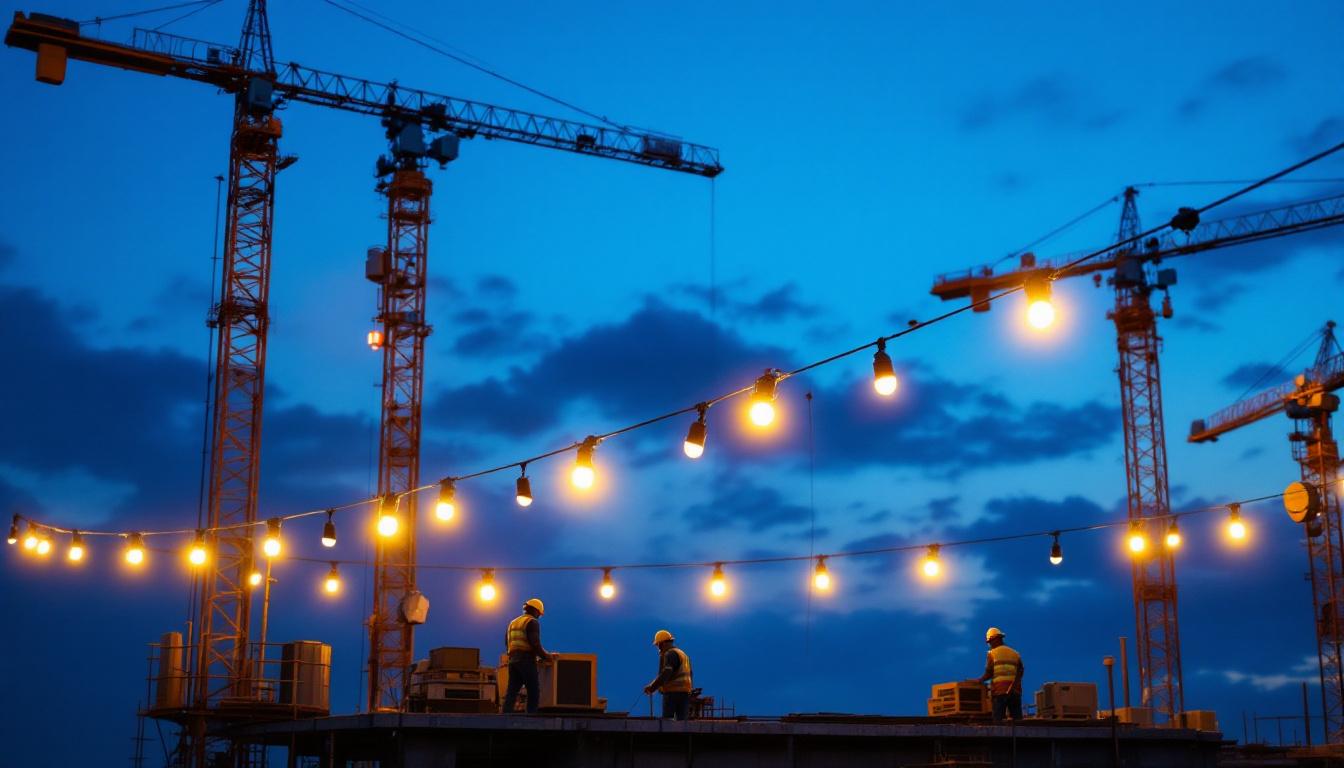
In the world of construction, lighting plays a critical role in ensuring safety, efficiency, and productivity on job sites. Among the various lighting options available, string lights have emerged as a popular choice for contractors. This article delves into the impact of construction lights string on lighting contractors’ projects, exploring their benefits, applications, and considerations for effective use.
Construction string lights are versatile lighting solutions designed specifically for outdoor and indoor construction sites. These lights consist of multiple bulbs connected by a durable cord, allowing for easy installation and flexibility in placement. Their design is tailored to withstand the rigors of construction environments, making them a reliable choice for contractors.
One of the standout features of construction string lights is their durability. Built to endure harsh weather conditions and rough handling, these lights often come with weather-resistant materials and shatterproof bulbs. This resilience ensures that they can continue to function effectively throughout the duration of a project. Additionally, many models are equipped with heavy-duty sockets that can accommodate a variety of bulb types, providing further versatility in lighting options.
Another significant feature is the ease of installation. Contractors can quickly set up string lights without the need for complex tools or extensive electrical knowledge. This simplicity allows for rapid deployment, ensuring that workers have adequate lighting as soon as they arrive on-site. Furthermore, many construction string lights come with integrated hooks or clips, making it even easier to hang them securely in various configurations, whether draped across beams or strung along fences.
There are various types of construction string lights available, each catering to different needs and environments. LED string lights are increasingly popular due to their energy efficiency and long lifespan. They produce bright illumination while consuming less power, making them an eco-friendly option. Moreover, LED lights generate less heat, which can be a significant advantage in preventing heat-related hazards on construction sites.
Incandescent string lights, although less energy-efficient, provide a warm glow that some contractors prefer for aesthetic reasons. These lights can create a more inviting atmosphere, particularly in settings where workers need to feel comfortable and motivated. Additionally, incandescent options can be dimmed or brightened depending on the task at hand, allowing for greater control over the lighting environment. Beyond these two primary types, there are also solar-powered string lights that offer an excellent solution for remote locations where access to electricity is limited, promoting sustainability while ensuring that work can continue uninterrupted.
Incorporating string lights into construction projects offers numerous advantages. From enhancing safety to improving productivity, the benefits are substantial and can significantly impact the overall success of a project.
Safety is paramount on any construction site. Adequate lighting is crucial for preventing accidents and ensuring that workers can navigate the site without hazards. String lights provide consistent illumination, reducing shadows and dark areas where accidents might occur.
Moreover, well-lit workspaces can help to improve visibility for tasks that require precision, such as electrical work or detailed installations. By minimizing the risk of accidents, contractors not only protect their workforce but also reduce potential liabilities associated with workplace injuries. Additionally, string lights can be easily installed and repositioned, allowing for quick adjustments as the project evolves, ensuring that safety remains a top priority throughout the construction process.
Good lighting can significantly enhance worker productivity. When employees can see clearly, they can work more efficiently and with greater focus. String lights create an environment conducive to productivity by illuminating work areas effectively.
Furthermore, the ability to customize the placement of string lights allows contractors to target specific areas that require more light. This flexibility enables teams to adapt to changing project needs and ensures that all tasks can be completed without delay. In addition to improving visibility, the warm glow of string lights can create a more inviting atmosphere, which can boost morale among workers. A positive work environment often leads to higher job satisfaction and can encourage teamwork, resulting in a more cohesive and motivated workforce that is eager to meet project deadlines.
Construction string lights are versatile and can be applied in various scenarios across different types of projects. Understanding these applications can help contractors make informed decisions about their lighting strategies.
Outdoor construction projects often require robust lighting solutions to ensure safety and visibility during nighttime work. String lights can be strung between poles, scaffolding, or other structures to provide widespread illumination across large areas. This setup is particularly beneficial for projects that extend into the evening or require extended hours of operation.
Additionally, outdoor string lights can enhance the ambiance of a construction site, making it more inviting for workers and visitors alike. This can foster a positive work environment, which is essential for maintaining morale and productivity.
In indoor settings, string lights can be used to illuminate specific areas, such as hallways, staircases, or workstations. Their portability allows contractors to easily reposition lights as needed, ensuring that every corner of the site is adequately lit.
Moreover, string lights can be particularly useful in renovation projects where existing lighting may be insufficient or temporarily disabled. They provide a reliable source of light that can be adjusted as the project evolves.
While construction string lights offer numerous benefits, there are several considerations that lighting contractors should keep in mind to maximize their effectiveness.
One of the primary considerations when using string lights is the power supply. Contractors must ensure that they have access to adequate electrical sources to support the lights. This may involve using generators or tapping into existing electrical systems, depending on the site’s infrastructure.
Additionally, proper wiring is essential to prevent electrical hazards. Contractors should ensure that all connections are secure and that the lights are rated for the intended use. This diligence helps to mitigate risks associated with electrical failures or short circuits.
Compliance with local regulations and safety standards is crucial when using construction string lights. Contractors should familiarize themselves with any relevant codes that govern lighting on construction sites. This knowledge can help avoid penalties and ensure that the project meets safety requirements.
Moreover, adhering to regulations can enhance the overall safety of the site, as many codes are designed to protect workers and the public from potential hazards.
To maximize the benefits of construction string lights, contractors should follow best practices during installation and use. These practices can help ensure that lighting is effective, safe, and compliant with regulations.
Strategic placement of string lights is essential for achieving optimal illumination. Contractors should assess the layout of the construction site and identify areas that require the most light. By focusing on high-traffic areas and work zones, contractors can enhance visibility where it matters most.
Additionally, lights should be positioned to minimize glare and shadows. This can be achieved by angling the lights appropriately and ensuring that they are not obstructed by equipment or materials.
Regular maintenance and inspection of string lights are vital for ensuring their continued effectiveness. Contractors should routinely check for any damaged bulbs, frayed cords, or loose connections. Promptly addressing these issues can prevent larger problems and ensure that the lights remain operational throughout the project.
Furthermore, maintaining a clean lighting environment can enhance the longevity of the lights. Dust and debris can accumulate on bulbs, diminishing their brightness. Regular cleaning can help maintain optimal performance.
The construction industry is continually evolving, and so are the technologies and methodologies used in lighting. Understanding future trends can help lighting contractors stay ahead of the curve and make informed decisions about their lighting strategies.
One of the emerging trends in construction lighting is the integration of smart technology. Smart string lights equipped with sensors and connectivity features can offer enhanced control and efficiency. For instance, lights can be programmed to adjust brightness based on ambient light levels or can be controlled remotely via mobile devices.
This technology not only improves energy efficiency but also allows for greater flexibility in managing lighting across large construction sites. As smart technology becomes more prevalent, contractors who adopt these solutions may gain a competitive edge in the market.
As sustainability becomes a more significant focus in construction, energy-efficient lighting solutions will continue to gain traction. LED string lights, known for their low energy consumption and long lifespan, are likely to dominate the market. Contractors who prioritize sustainable lighting options can reduce their environmental impact and appeal to clients who value eco-friendly practices.
Moreover, incorporating energy-efficient lighting can lead to cost savings over time, as reduced energy consumption translates to lower utility bills. This financial incentive, combined with the environmental benefits, makes a compelling case for the adoption of sustainable lighting solutions.
Construction string lights have a profound impact on lighting contractors’ projects. Their versatility, durability, and ease of installation make them an invaluable tool for enhancing safety and productivity on job sites. By understanding the benefits, applications, and best practices associated with string lights, contractors can make informed decisions that contribute to the success of their projects.
As the construction industry continues to evolve, staying abreast of emerging trends and technologies will be crucial for lighting contractors. Embracing smart lighting solutions and prioritizing sustainability will not only enhance project outcomes but also position contractors as leaders in an increasingly competitive market.
Ready to elevate your construction lighting game? Look no further than LumenWholesale for a comprehensive range of top-quality, spec-grade construction string lights and more. With unbeatable wholesale prices and the convenience of cutting out the middleman, you’re guaranteed superior lighting products without the inflated markups. Our selection not only meets but exceeds industry standards, ensuring your projects shine with reliability and high performance. Plus, with free shipping on bulk orders, you can stock up on premium lighting at the best value — without any hidden fees. Don’t compromise on quality or cost. Make your next project a beacon of efficiency and safety with Wholesale Lighting at the Best Value from LumenWholesale.
Discover the pivotal role of LED flat panel lighting in modern lighting projects.

Discover the transformative journey of fluorescent light bulbs, from their invention to their pivotal role in revolutionizing the lighting industry.

Discover the essential do’s and don’ts for lighting contractors when installing bedroom light sconces.

Discover the ultimate resources for mastering linear outdoor lighting with insights from top lighting contractors.